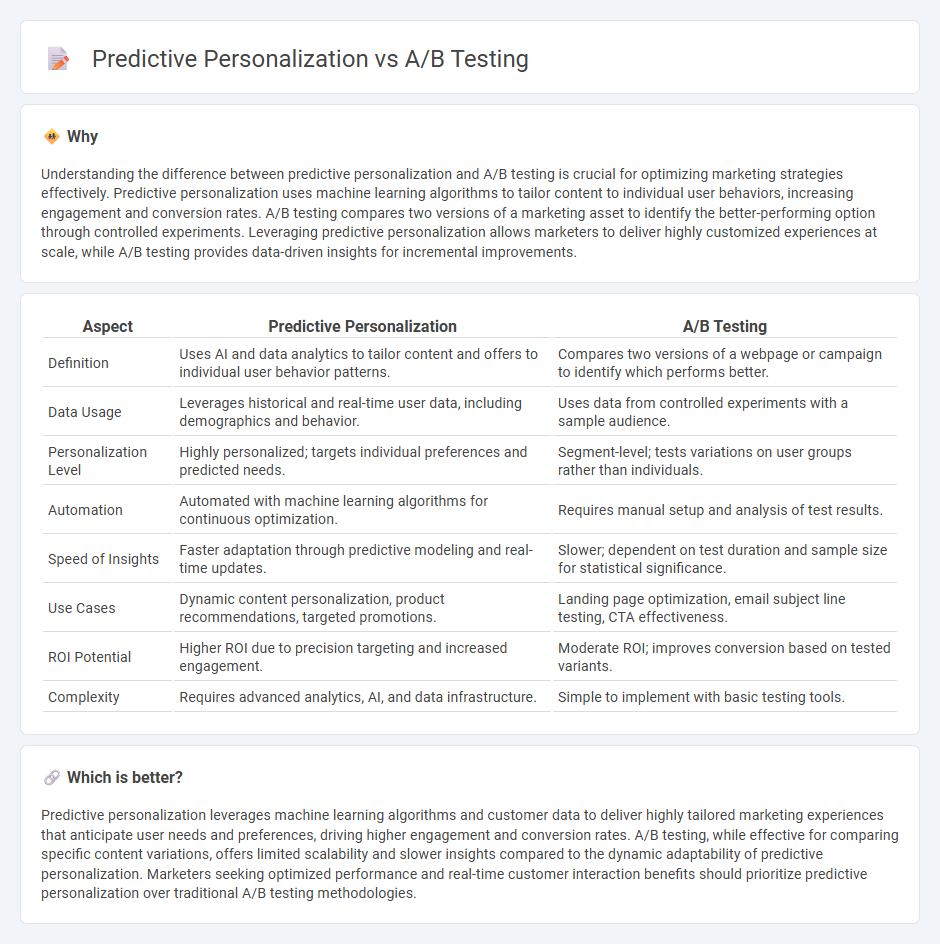
Predictive personalization leverages machine learning algorithms to analyze customer data and anticipate individual preferences, delivering tailored marketing experiences in real-time. In contrast, A/B testing systematically compares two versions of a marketing asset to determine which performs better based on user interactions. Explore how integrating predictive personalization with A/B testing can revolutionize your marketing strategy.
Why it is important
Understanding the difference between predictive personalization and A/B testing is crucial for optimizing marketing strategies effectively. Predictive personalization uses machine learning algorithms to tailor content to individual user behaviors, increasing engagement and conversion rates. A/B testing compares two versions of a marketing asset to identify the better-performing option through controlled experiments. Leveraging predictive personalization allows marketers to deliver highly customized experiences at scale, while A/B testing provides data-driven insights for incremental improvements.
Comparison Table
| Aspect | Predictive Personalization | A/B Testing |
|---|---|---|
| Definition | Uses AI and data analytics to tailor content and offers to individual user behavior patterns. | Compares two versions of a webpage or campaign to identify which performs better. |
| Data Usage | Leverages historical and real-time user data, including demographics and behavior. | Uses data from controlled experiments with a sample audience. |
| Personalization Level | Highly personalized; targets individual preferences and predicted needs. | Segment-level; tests variations on user groups rather than individuals. |
| Automation | Automated with machine learning algorithms for continuous optimization. | Requires manual setup and analysis of test results. |
| Speed of Insights | Faster adaptation through predictive modeling and real-time updates. | Slower; dependent on test duration and sample size for statistical significance. |
| Use Cases | Dynamic content personalization, product recommendations, targeted promotions. | Landing page optimization, email subject line testing, CTA effectiveness. |
| ROI Potential | Higher ROI due to precision targeting and increased engagement. | Moderate ROI; improves conversion based on tested variants. |
| Complexity | Requires advanced analytics, AI, and data infrastructure. | Simple to implement with basic testing tools. |
Which is better?
Predictive personalization leverages machine learning algorithms and customer data to deliver highly tailored marketing experiences that anticipate user needs and preferences, driving higher engagement and conversion rates. A/B testing, while effective for comparing specific content variations, offers limited scalability and slower insights compared to the dynamic adaptability of predictive personalization. Marketers seeking optimized performance and real-time customer interaction benefits should prioritize predictive personalization over traditional A/B testing methodologies.
Connection
Predictive personalization utilizes data analytics and machine learning algorithms to forecast customer preferences, enhancing targeted marketing strategies. A/B testing empirically compares variations in personalized content to identify the most effective approach for user engagement. Together, they enable marketers to optimize campaigns by dynamically adjusting messages based on predictive insights validated through experimental evidence.
Key Terms
Experimentation
A/B testing compares different versions of content to identify the highest performer through controlled experiments, providing data-driven insights for optimization. Predictive personalization uses machine learning algorithms to forecast individual user preferences and deliver tailored experiences in real-time, enhancing engagement and conversion rates. Explore the advantages of both approaches to maximize your experimentation strategy.
Machine Learning
A/B testing compares different versions of content or user experiences by dividing traffic to determine which performs better, relying on historical data and manual hypothesis generation. Predictive personalization uses machine learning algorithms to analyze user behavior and predict preferences in real time, delivering dynamically tailored experiences that improve engagement and conversion rates. Explore detailed insights on how machine learning transforms personalization beyond traditional A/B testing methods.
Segmentation
A/B testing segments audiences by predefined groups to compare variations, delivering insights on user preferences through direct comparison. Predictive personalization uses machine learning algorithms to analyze behavioral data, creating dynamic, individualized segments that adapt over time. Explore how combining these strategies can maximize your segmentation effectiveness and drive targeted engagement.
Source and External Links
What is A/B testing? With examples - Optimizely - A/B testing, also known as split testing, compares two versions of a webpage or app by showing them randomly to users and using statistical analysis to determine which variation better achieves conversion goals.
A/B testing - Wikipedia - A/B testing is a randomized controlled experiment comparing two versions of a variable (like an email or webpage) to evaluate which performs better, often using statistical testing to confirm significance.
A/B Testing 101 - NN/g - A/B testing is a quantitative UX research method that tests two or more design variants with live users by splitting traffic and measuring which version best meets business success metrics.
 dowidth.com
dowidth.com